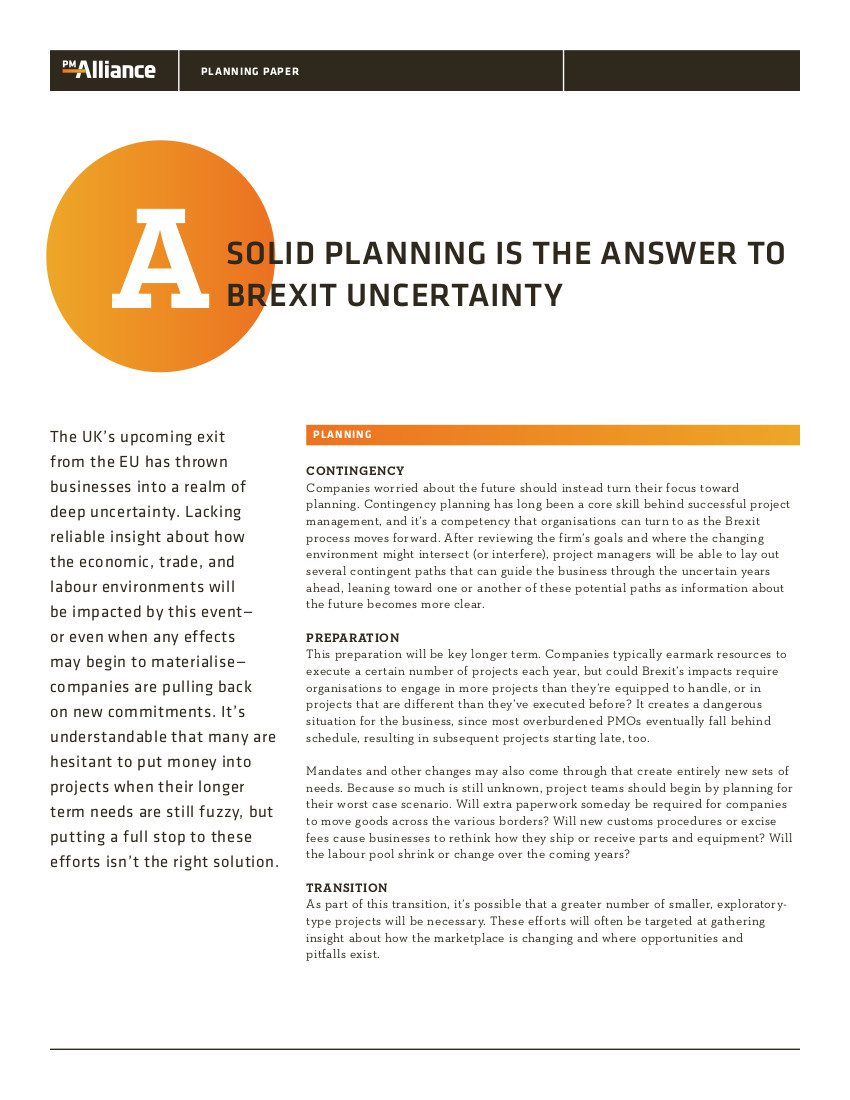
Market Uncertainty, Resource Management, and Project Success
The ongoing economic uncertainty —what its impacts will be in the marketplace and when those effects will be felt—has many companies considering where they may

The ongoing economic uncertainty —what its impacts will be in the marketplace and when those effects will be felt—has many companies considering where they may

Project teams are increasingly aware of the value of using a dynamic schedule to sequence and oversee activities. With the ability to effectively address any schedule impacts by reflowing or compressing tasks to maintain alignment with the target completion date, the center of excellence gains tangible benefits that can help keep difficult or complex projects on track.

Testing and QC programs are a useful and necessary part of the manufacturing sector, but PMs need to be ready to address the significant impacts these activities can have on projects that are already in progress. Once the results of a testing or QC program are released, the effects on the project can range from delays in downstream activities to changes in the project’s scope. Successfully executing tasks in spite of these impacts—sticking to the target completion date and approved budget—can be tricky. But while juggling mid-project changes is often challenging, there are strategies organizations can use to ensure that testing and QC efforts don’t put the project’s success in jeopardy.

Companies worried about the future should instead turn their focus toward planning. Contingency planning has long been a core skill behind successful project management, and it’s a competency that organizations can turn to as the Brexit process moves forward. After reviewing the firm’s goals and where the changing environment might intersect (or interfere), project managers will be able to lay out several contingent paths that can guide the business through the uncertain years ahead, leaning toward one or another of these potential paths as information about the future becomes more clear.

Project Schedule Challenges exist in every type of project, but manufacturing efforts bring with them some unique risks and obstacles. Outside influences and unexpected developments

There are many potential challenges hiding within manufacturing projects. Without the right kind of planning and preparation, issues can crop up with little warning and cause Project Teams to compensate by cutting corners, either in the level of work being performed, the materials used, or even in the overall scope of the project.

Project schedules are rarely static. Instead, they begin evolving as soon as the team gets to work. Status reports coming in from the field, issues such as material and equipment delivery timing, and labor availability will all impact the schedule throughout the project’s lifecycle.

Project managers essentially have two areas of focus when it comes to manpower support:
Knowing that they have enough of the right resources to execute the amount of work planned, ensuring they aren’t caught short-handed at a critical time.
Understanding when those resources are needed—and when they’re best used—so they don’t have expensive labor resources onsite without anything to do.
If the team isn’t adequately staffed with the right level of labor resources to complete the amount of work being scheduled, the activity durations will ultimately take longer. This often leads to some of the project’s scope being sacrificed toward the end of the project as the team runs out of time leading up to the target completion date.

Complex projects often have more than one critical path, and in order for the project to reach a successful completion, each of these paths must be carefully managed. Even if the primary path is achieved, a lack of progress on any of the follow-on paths could doom the project to failure in the long run.
Teams that execute these challenging projects need to be mindful of what it takes to manage multiple layers of requirements and actions. A strong awareness of all the paths that make up a project is critical if the Project Team wants to ensure that nothing falls behind schedule or drops off the radar.
If your center of excellence is facing a can’t-fail project with multiple paths, it’s important to understand the risks that exists and where opportunities for success can be found.

Information is one of the core pillars underpinning every successful project. With the evolution of technology and more compute power available than ever before, there’s little reason centers of excellence should continue to rely on data that may be days or even weeks old when it comes to identifying potential issues, forecasting activity schedules, making strategic decisions, and pouncing on opportunities in the marketplace.
A robust project management methodology enables the team to access the kind of real-time status updates that are critical to success. If your Project Team hasn’t yet prioritized the use of real-time data, consider how it could improve the landscape for team members, executives, and the other stakeholders involved in the effort.

We partner with our clients to provide mission-critical project management solutions.
Corporate Headquarters
3355 Lenox Road
Suite 750
Atlanta, GA 30326
Toll-free (US): 866.808.3735
International: +1.770.938.4947
Fax: 770.234.6997
PMP, PMI, PMBOK, CAPM are registered marks of the Project Management Institute, Inc.
We use cookies to enhance your browsing experience, analyze site traffic, and personalize content. By continuing to use our site, you consent to our use of cookies.